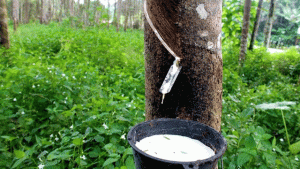Technical Info
Rubber is a flexible material made from the juice sap (latex) of some tropical plants or petroleum and natural gas. The rubber produced from the juice sap of trees is called natural rubber and the rubber produced from petroleum products is called synthetic rubber. Both types are versatile materials.
Rubber is a durable and flexible material derived from the rubber tree and has a great place in today's industry.  The rubber tree takes its name from the indian language, it means weeping tree in their language. The indians saw that a white, sticky and milky liquid leaked from the tree, then dried it over time and started making toy balls.
The rubber tree takes its name from the indian language, it means weeping tree in their language. The indians saw that a white, sticky and milky liquid leaked from the tree, then dried it over time and started making toy balls.
More than 15 million tons of rubber are produced annually around the world; About a third of it is natural rubber. Due to the demand of natural rubber, in order to obtain cheap and in abundance rubber, synthetic or artificial rubber was produced by the Germans in the 1900s and thus many types of rubber showed up. When natural rubber is stretched over and over again, it almost returns to its original size. This feature distinguishes natural rubber from synthetic rubber and all other materials containing rubber.
Rubber, which is found in products such as shoes, raincoats, buttons, combs and belts that we use in our daily life, is also widely used in tires. It is a very important product due to its softness, durability, adhesiveness, water and air impermeability, and is used extensively in areas such as insulation because it does not conduct electricity.
Today, rubber is as widely used as wood. Its beneficial properties such as great strength, long life, water and heat resistance make this material perfect for tire production. In fact, a large percentage of rubber production is in the automotive industry. Rubber has a wide variety of colors, styles and textures and is extremely various.
The most important feature of rubber is that it has a high elasticity. When heated, it softens and melts at 220°C. Then, with the distillation, rubber oil is obtained and this oil is used to dissolve the rubber.

| Type of Rubber | Code | Working Temperature | Usage Areas | |||
| Min | Max | |||||
| NITRILE Rubber | NBR | 55 °C |
135 °C |
|
||
| CHLOROPRENE Rubber (Neoprene) | CR | 40 °C |
120 °C |
|
||
| ETHYLENE PROPYLENE Rubber |
EPDM - EPM | 65°C |
170°C |
|
||
| Styrene-Butadiene Rubber |
SBR | 60 °C |
125°C |
|
||
| Polyurethane |
AU - EU | 60 °C |
90 °C |
|
||
| SILICONE | VSI - MQ | 70 °C |
230 °C |
|
||
| FLUOROELASTOMER (FLUORINATED) |
FKM | 25 °C |
260 °C |
|
||
| NATURAL Rubber | NR | 60 °C |
100 °C |
|
||
